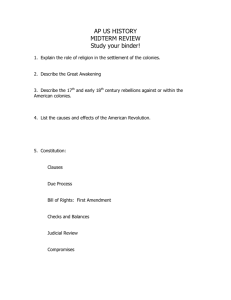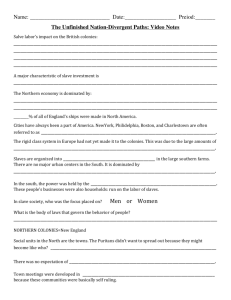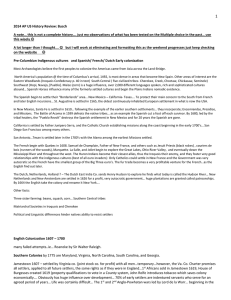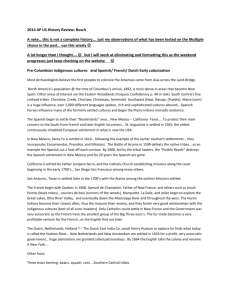USI Midterm Study Guide
advertisement
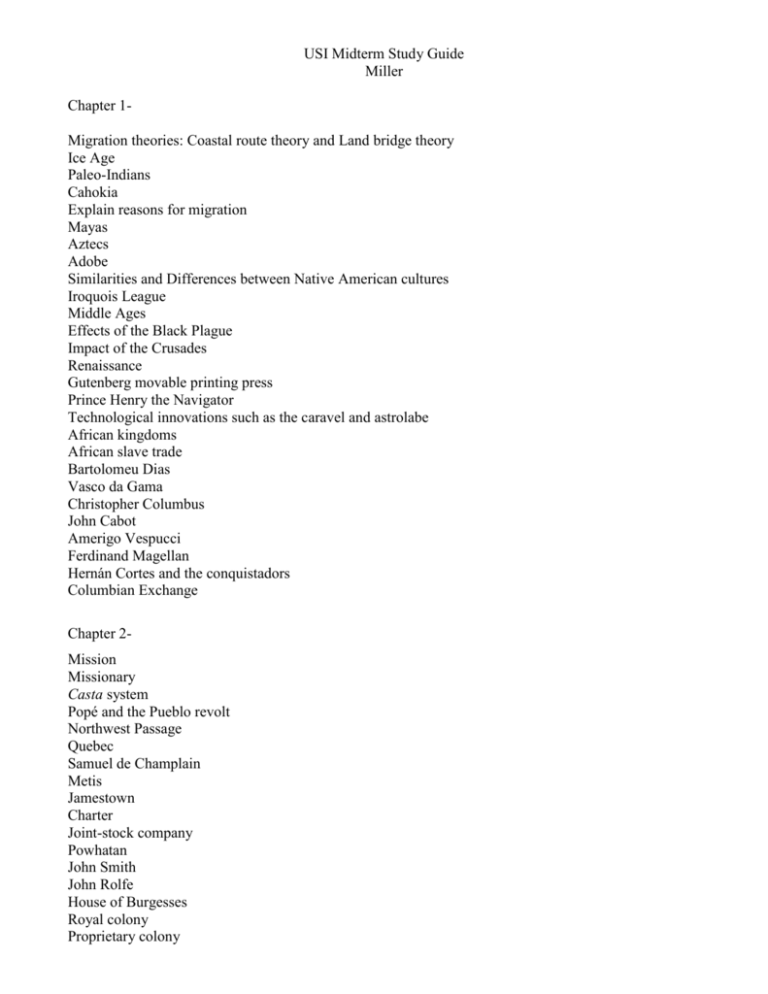
USI Midterm Study Guide Miller Chapter 1Migration theories: Coastal route theory and Land bridge theory Ice Age Paleo-Indians Cahokia Explain reasons for migration Mayas Aztecs Adobe Similarities and Differences between Native American cultures Iroquois League Middle Ages Effects of the Black Plague Impact of the Crusades Renaissance Gutenberg movable printing press Prince Henry the Navigator Technological innovations such as the caravel and astrolabe African kingdoms African slave trade Bartolomeu Dias Vasco da Gama Christopher Columbus John Cabot Amerigo Vespucci Ferdinand Magellan Hernán Cortes and the conquistadors Columbian Exchange Chapter 2Mission Missionary Casta system Popé and the Pueblo revolt Northwest Passage Quebec Samuel de Champlain Metis Jamestown Charter Joint-stock company Powhatan John Smith John Rolfe House of Burgesses Royal colony Proprietary colony Bacon’s Rebellion Lord Baltimore James Oglethorpe Importance of tobacco John Calvin and predestination Puritans vs. Pilgrims Separatists Anglican Church Mayflower Compact John Winthrop and the “city upon a hill” Roger Williams Anne Hutchinson Salem Witch Trials Pequot War King Philip’s War Push Factors Pull Factors William Penn Quakers Compare and contrast Northern, Middle, and Southern colonies Locations of English, French, and Spanish colonies. Major economic activities in Spanish colonies? In French? In English? Government in Spanish colonies? In French? In English? Chapter 3Indentured servants Why did the supply of indentured servants from England decline after 1660? Scotch-Irish Germans Slavery- How and why does it begin? How does it evolve into a system of racial slavery? Triangular trade Middle Passage African American culture Slave resistance Magna Carta Parliament Bicameral Glorious Revolution English Bill of Rights Habeas Corpus Salutary neglect John Peter Zenger Mercantilism Navigation Acts The Consumer Revolution Enlightenment John Locke Benjamin Franklin Albany Plan of Union Great Awakening Jonathan Edwards George Whitefield Cash crops Geographic and economic differences between the New England, Middle, and Southern Colonies Education in the colonies Government in the colonies The French and Indian War Treaty of Paris Pontiac’s Rebellion Proclamation of 1763 Albany Plan of Union (1754) Chapter 4In what ways did the system of English government influence the colonists? (Describe the English government and think of the rights/freedoms that the colonists inherited from England) How did England and the colonies compare/contrast in terms of democratic participation (voting, etc.)? Parliament Bicameral legislature Virtual representation Sugar Act Stamp Act In what ways did the colonists protest the Stamp Act? Taxation Without Representation John Adams Influence of the Enlightenment Patrick Henry Sons of Liberty Nonimportation agreements Role of women in colonial protests Townshend Acts Boston Massacre Committees of Correspondence Boston Tea Party Intolerable Acts First and Second Continental Congress Militia Battles of Lexington and Concord Loyalists Patriots George Washington “Olive Branch Petition” Thomas Paine and Common Sense Declaration of Independence Thomas Jefferson Natural Rights Unalienable Rights The American Crisis Battle of Trenton Battle of Princeton When and why does France enter the war? Benjamin Franklin Valley Forge The Frontier war Yorktown Treaty of Paris Impact of the Revolution on Women Impact of the Revolution on African Americans Manumission Influence of Revolutionary ideas Chapter 5Characteristics of early state governments Articles of Confederation Northwest Ordinance of 1787 Shays’ Rebellion Constitutional Convention Virginia Plan New Jersey Plan Great Compromise Three-fifths Compromise Slave trade Compromise Electoral College Federalism Separation of Powers Checks and Balances Popular Sovereignty Federalists vs. Anti-Federalists John Jay Alexander Hamilton James Madison Federalist Papers


